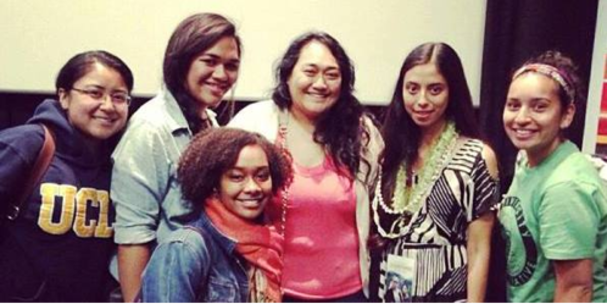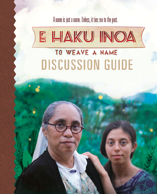
The Namesake Project, and Other Audience Engagement Ideas
By Christen Hepuakoa Marquez
(Above image: Director Christen H. Marquez with members of UCLA's Pacific Islander Student Association (PISA) at the 2013 Los Angeles Asian Pacific Film Festival)
I am almost a year out from the broadcast premiere of my documentary film E Haku Inoa: To Weave a Name and I am now able to take a look back at my audience engagement efforts with a reasonable amount of perspective. The goal of any documentary engagement initiative is to create outlets for meaningful dialogue and interaction with your film's audience. Sometimes in the era of online metrics it is tempting to feel like an engagement failure if you can't generate 10,000 likes on your Facebook posts, but I have found it helpful to instead concentrate on creating opportunities for quality engagement that are rewarding for me as the filmmaker. Not to say that having a large audience isn't a great thing, but it is important, especially for smaller documentaries with limited budgets, to scale their expectations and not get overwhelmed. Audience engagement is a marathon effort that will be more effective if it is enjoyable for you and your outreach partners.
Now that films and filmmakers have the capability of being constantly connected with their audience, engagement is not something that is limited to after the release of your film. In fact, it is almost always an advantage to start engaging your audience as soon as you can. You will see this article is organized into five categories of engagement. Some are examples that I have used for my film, and a few are from other filmmakers, but one thing to keep in mind is that any of these categories can be tapped into during pretty much any phase of your film's life from development through distribution.
Online
For online engagement of my film Haku I use four different online platforms; Facebook, Twitter, YouTube, and the film's website.
On YouTube I created a new media project called The Namesake Project that tied into the theme of inoa (names) and how everyone has a meaning or story to their name. I implemented this project during the festival run of the film and I can revisit it anytime. It is a fun and relatively easy engagement activity to do at screenings or seminars that helped people connect personally to the film. It is a good example of how face-to-face engagement (see below) can help strengthen your online engagement. You can see the online call to action that I produced here, and here is one of my favorite name stories that I collected:
Facebook and Twitter were useful for keeping in touch with audiences throughout the making of my film. I tried to funnel most of my audience questions and answers through these two online platforms because I found them the most convenient to use. During the ramp up phase before my film’s broadcast I posted to these pages relatively frequently. For me that meant about once a day, however, some social media experts would suggest posting between three and fives times a day.
Now that my film has finished its festival run and national broadcast I am updating these pages much less frequently, but still checking and responding when new viewers and fans leave comments. I suggest following other films that are similar to your film to get examples of what other filmmakers are doing to engage audiences on these platforms. This will also help you find content that might be relevant for your film's page. Two Facebook film pages that are great to follow as examples of well-run pages and have Pacific Islander content are Kumu Hina and In Football We Trust.
Online engagement is a very important part of a modern documentary engagement plan, but it is important to know other modes of engagement that are equally important.
 Classroom and Educational
Classroom and Educational
Educational distribution for universities has always been a part of my strategy not only as outreach, but to help create an ancilliary income stream after public television broadcast. One tactic was to create a discussion guide to accompany the film which is now available for download. Another tactic was to participate in interviews via Skype or phone with schools including Kamehameha Schools and Hilo Community College, and staff education screenings with mental health organizations like the Substance Abuse and Mental Health Administration.
Community
I define “community” in community engagement as any place where there is a public forum that facilitates discussion of your project's topics. Community screenings and other less formal gatherings are a staple of community engagement. The discussion guide has been a helpful tool for facilitating this kind of engagement when I can't personally attend. I began taking part in this type of screening in advance of my public television broadcast with groups like Pacific Islander health organizations and Hawaiian civic clubs on the continent. This benefitted the film two-fold: first, I was able to get feedback on the final film to gauge what the larger reaction to the film would be, and secondly I was able to indentify influencers within the community who could tell their friends that the film would be broadcasting in their local area.
Of course you should not limit your community engagement only to screenings. During the development of my film I was fortunate to have created a partnership with PBS Hawaii, the local Hawaii public television affiliate. This opened up the opportunity to be featured on two episodes of Insights, the live broadcast hour-long interview show produced by PBS Hawaii. The first episode focused entirely on Native Hawaiian Mental Health and helped raise awareness about the upcoming broadcast of the film, and the second episode immediately followed the broadcast premiere of the film with a live studio audience, which you can see below. The good stuff starts in at 5:51 in the program.
Face-to-Face
This is a simple and sometimes overlooked component to audience engagement, but attending as many screenings as possible in person without getting burnt-out is a great way to build audience engagement. Just be sure to pass around an email list so you can stay connected with your audience for future projects or additional screenings in their area so they can stay in touch with you and your work. A face-to-face connection that is supported with meaningful online and email engagement is a really great way to build supporters of your films and your work.
Get Creative!
When it comes to audience engagement you are only limited by your imagination and motivation. Think of creative ways that you can begin getting people involved with the content of your film, and remember that as a small independent filmmaker the earlier you can get your audience engaged and building momentum for your film the better. This may be overwhelming for a single filmmaker, but if you can partner with organizations early on it can be very beneficial to your project.
One great example of this is a film that is currently in production called I Am Hāloa, which is about Hawaiian culture as it relates to food sovereignty. They are working very closely with Mana ʻAi, an organization that offers mobile workshops that show people how to prepare kalo (taro), a traditional Hawaiian staple food. These workshops literally get peoples’ hands in touch with content related to the film and is a genius way to build engagement with the film.
I hope this gets your creative audience engagement energy flowing! I would love to hear about ideas that you come up with after reading this article. Also, if you have any questions about ideas for monetizing your audience engagement, please write those in the comments or on my Facebook page. I am writing a follow-up to this article about distribution avenues for documentaries funded through the public television system, and I would love to incorporate reader questions into that article.
Mahalo nui and happy engaging!
Christen Hepuakoa Marquez is a Hawaiian independent producer and filmmaker living in Los Angeles. Her company website is www.paradocsproductions.com, and her portfolio can be seen at www.christenm.com.
Categories: Broadcast, Producers' Post